Almost every wildlife/nature photographer who spends a lot of time in the field has occasionally put himself in a situation someone else might consider dangerous.
The primary camera equipment I use for wildlife shots: Canon 1D Mk II and a Canon 1DS Mk II camera bodies, 600mm f/4 lens, 70-200mm f/2.8 lens, 100-400 f/4.5 – 5.6 IS, 1.4 teleconverter, Speedlight 580EX II flash, teleflash, Wimberley head, and the Gitzo G1548.
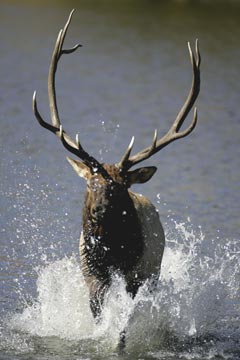
Copyright © Andy Long
A bull elk appears to be charging me, but it is actually chasing off a smaller bull that was coming into the area.
A bull elk is charging you, water flying everywhere, as it tries to clear the area of intruders during mating season–or so your photo makes it appear. However, what might look like a photographer (me, in this instance) in danger is an example of my being in the right position as one bull elk chases a second younger and smaller one from the area. I feel no fear as I see the position of the smaller elk and the angle the larger bull is taking to chase it away. The only emotion I feel is excitement, because I know I’m getting nice action shots of the bull elk in water.
A large bull elk charging would send many people scurrying for cover, possibly causing the elk to turn its attention to the fleeing person. But, as photographers, we intuitively have a feel for the situation and know if we’re facing danger. In fact, opportunities such as the two competing elk or a bear grasping for salmon in a river are ones almost every photographer dreams of shooting. I’m frequently asked if I’ve ever been in enough jeopardy to be scared when I’m doing photography. A quick no is the reply. I might have experienced a time or two when I should have sensed peril, but with my eyes pressed against the viewfinder while I clicked shot after shot, I (like so many other photographers in similar circumstances) blocked out fear.
What are the most exotic, hazardous things I’ve photographed? Once I had a bear approach to about twelve feet away from me, or another time I was only twenty to thirty yards away from a polar bear, or there was the time I was lying on the ground to get a tight shot–seven feet in front of a rattlesnake. When I tell my tales, I can see my listeners’ eyes widen as they exclaim that they would be scared to death in any of these situations. For me, they’re a walk in the park–one I look forward to when I’m trying to get wildlife shots that stand out from the crowd.
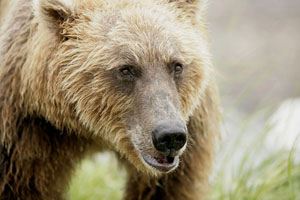
Copyright © Andy Long
Up close and personal. A bear walks by, eventually coming to within 12 feet, but he’s still not paying attention to our group.
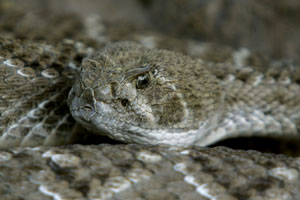
Copyright © Andy Long
Laying on the ground for a tight head shot after it had curled up for a night of rest.
A participant in one of my photographic workshops in the Tetons did learn the word “fear” one day, but the close call was no one’s fault. We were shooting a bull moose and his small groups of cows and young. One of the cows had wandered off into the willows while the bull and others still stood in the water. I kept looking around for her while taking a few shots, as the others on the trip concentrated on taking shots of the bull. I saw the cow working her way back to the water, this time into a different spot. Her eventual position was going to place the workshop participant between her and the bull. Before the cow reached the water, I yelled to my colleague to move left immediately. He turned around and saw the cow only ten feet behind him, and he darted left. Simultaneously, the bull realized the situation and arched his back in a protective, agitated state.
Later, the photographer said he thought his heart was going to jump out of his chest; now he knew the meaning of “fear.” He had done nothing wrong, but wildlife photographers must constantly be aware of their surroundings and what might happen. During mating season of the various large mammals, it’s best to keep looking around to see if a situation is developing. The best rule is to never allow yourself to be in a position between a male and one of his females.
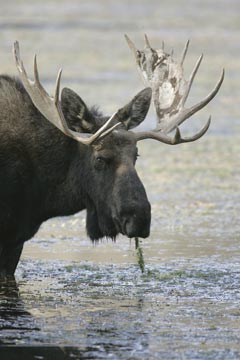
Copyright © Andy Long
At one point this bull moose was doing more than just glancing our way, as one of its cows came out from behind a photographer, making for a few tense seconds.
Danger is a relative term, depending on the individual photographer. Where one photographer who has a lot of years under his belt will feel no fear when an Alaska brown bear is bringing a salmon up on the bank to feed just a few yards away, another might think it’s time to beat feet and get out of there. Experience and knowing how to read animals are essential to taking that next step to becoming a great wildlife photographer. However, even experience doesn’t guarantee you won’t be surprised. You never know if a large male will suddenly decide he doesn’t want you in his area and will make a false charge. (Luckily, most of the time, an animal will give a warning that you are within its comfort zone before making a real charge.)
Sometimes, “fear” isn’t the word that describes your feelings, but you experience a sense of urgency as a young bear becomes curious and approaches your group while Mom looks on. The young bear doesn’t know it’s creating a potentially hazardous setting, but when Mom becomes concerned, you have to do something. This circumstance happened on my latest bear trip in Alaska. We started making plenty of noise to chase the baby bear off until it finally turned back toward its mother, returning calm to the scene.
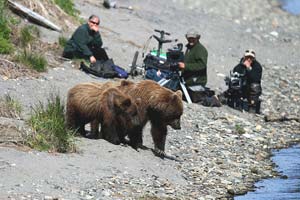
Copyright © Andy Long
A mother and young bear come over a ridge in front of some unsuspecting cameramen, causing for a moment of awareness.
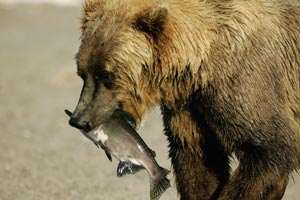
Copyright © Andy Long
An Alaska brown bear brings it catch ashore to have a meal.
Be warned; if you become complacent about a situation, something bad can happen. Never get to the point where you think nothing bad is ever going to happen to you, especially when you’re out by yourself. You have to be extra cautious when you’re alone, because you don’t have an extra pair of eyes surveying the scene that is playing out. Even the most wary individual can be caught unaware when faced with a potentially hazardous situation, as illustrated by the moose incident. Or what if you’re sitting in a blind that’s mostly below ground level and a rattlesnake makes a turn as though it might enter the opening you’re shooting through? That’s when you make a quick exit. (By the way, when a rattler curls up for an evening of sleep, they become docile and you can work around them feeling a bit more secure.)
A young bear eats a salmon about 20 feet away, not even paying attention to the nearby photographers.
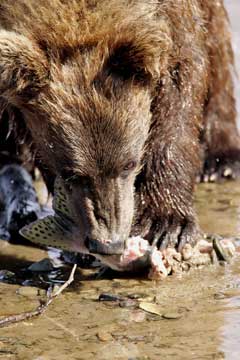
Copyright © Andy Long
Almost every wildlife/nature photographer who spends a lot of time in the field has occasionally put himself in a situation someone else might consider dangerous. The interpretation depends on your perspective. If we photographers were to really think about it (especially after the fact), we might admit that once in a while we were in more danger than we recognized. We just keep telling ourselves that the risk isn’t that bad. The people who love us might not agree.
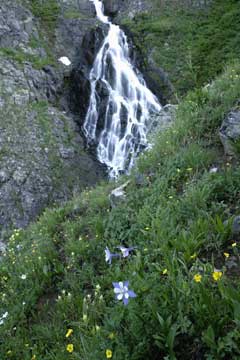
Copyright © Andy Long
A precarious slope could have spelled danger, but digging in and having someone hold on made the shot possible. After looking at it though, it wasn’t as impressive as I thought it would be. Maybe if I had just inched my way a bit closer.
When my new wife examined my full-frame headshots of an Alaska coastal brown bear, she wanted to know how close the bear was from me. I responded that the lens focuses no closer than seventeen feet, so I had to be at least that far away. Her response was that that was too close. Then there was the photo a workshop participant took of me jumping from one rock to another near a waterfall where there’s at least a hundred foot drop to the rocks below. “Don’t do that again,” she told me. I didn’t tell her how I got the shot of the columbine in the foreground and the waterfall in the background. Someone was practically holding my feet as I lay on the ground. I could easily have slid forward and down the cliff. All in a day’s work. Then there was the time.
by Andy Long

Leave a Reply